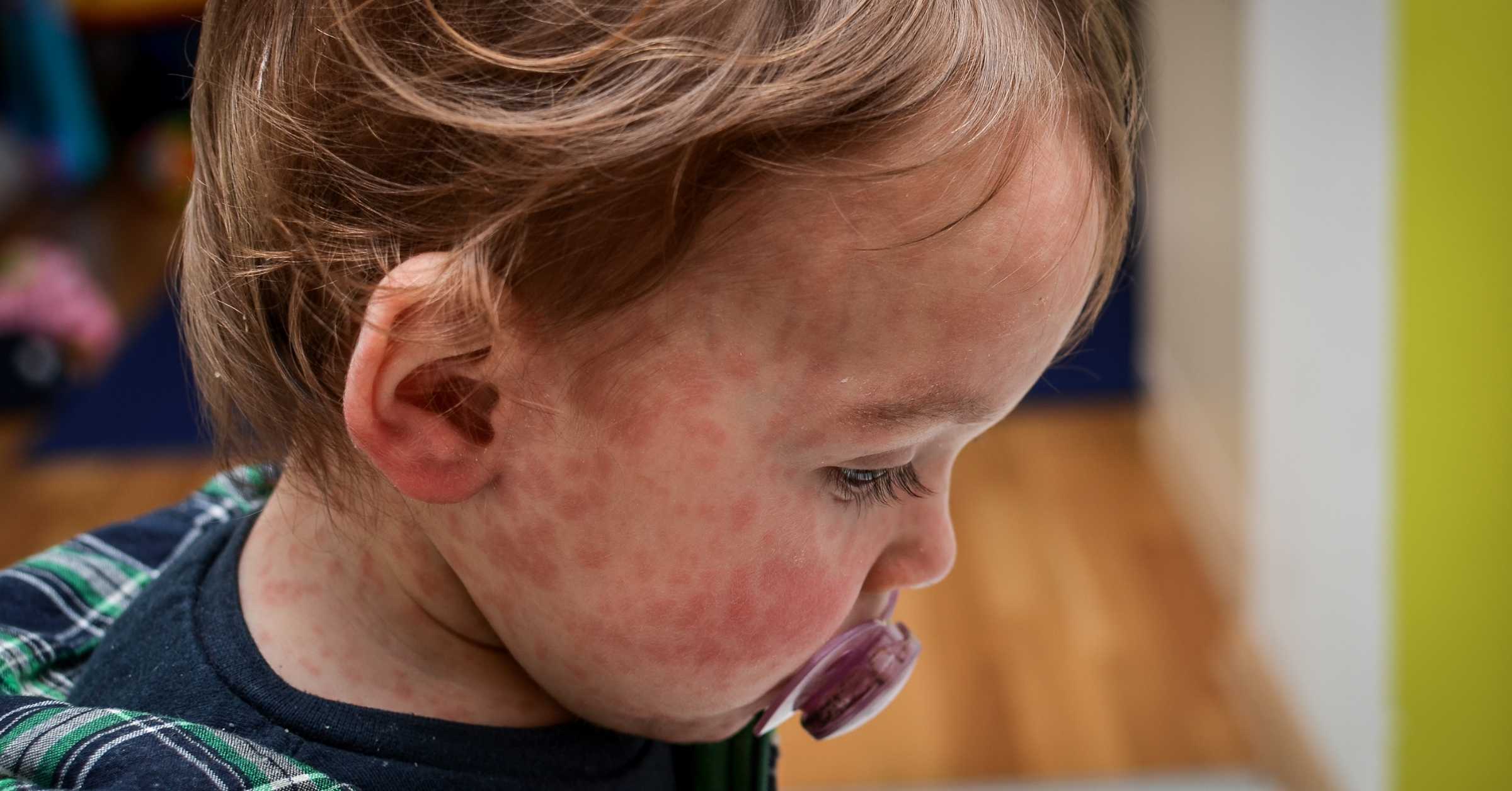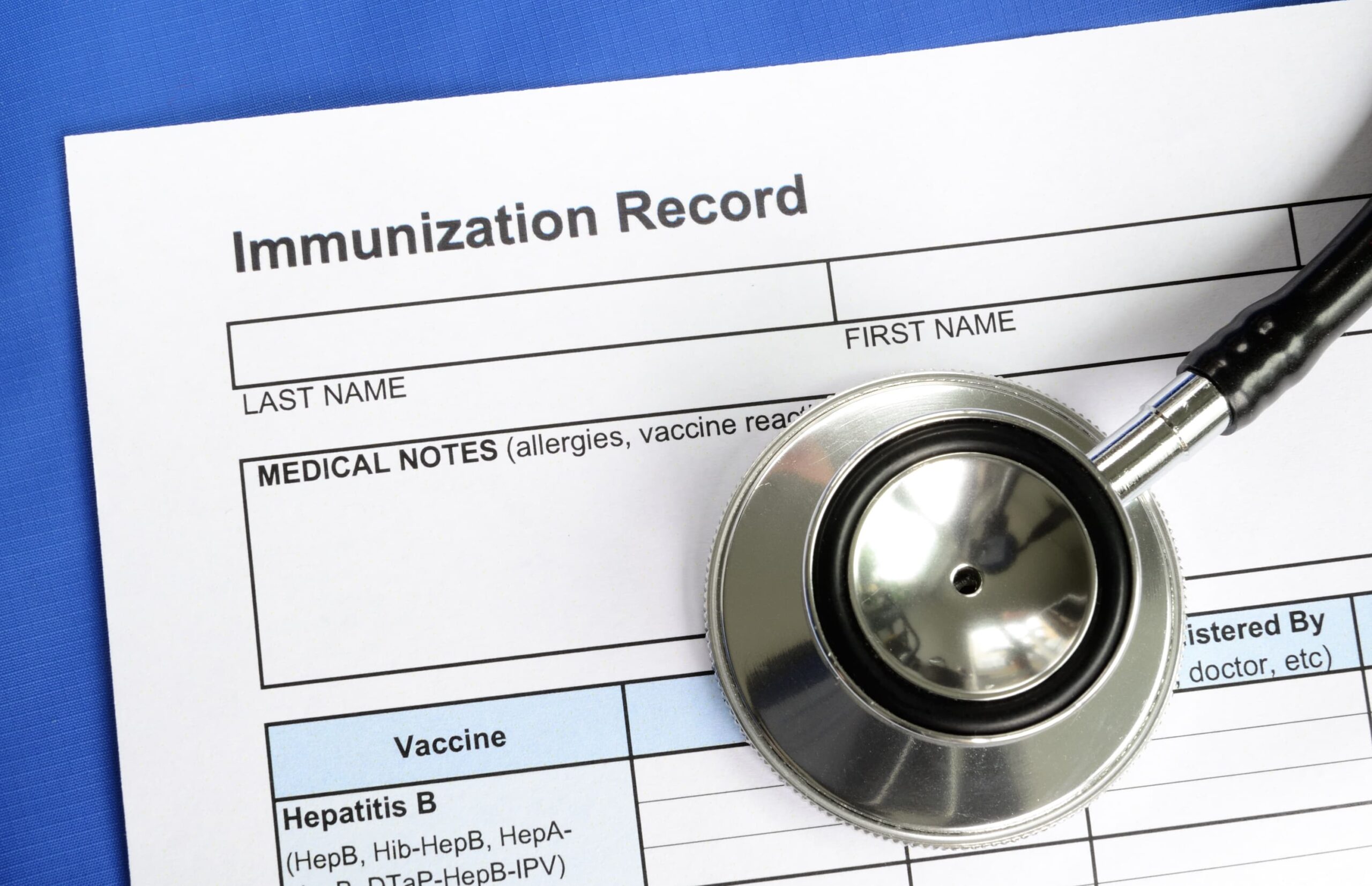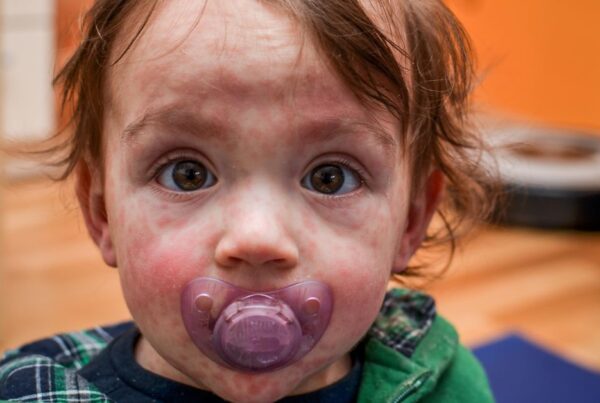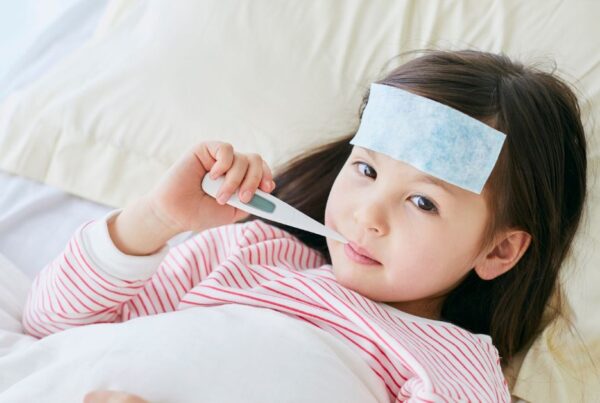Every few years, a measles outbreak occurs somewhere in the United States, leaving parents to wonder how to treat measles* if an outbreak occurs locally. This article answers the following questions: What is measles? How do I know if my child has measles? How do I treat measles at home? What are the best natural measles treatments? How effective is the measles vaccine? And more.
*This article outlines ways to manage symptoms and support healing of symptomatic measles. If you’re looking for steps you can take after being exposed but before developing symptoms of measles, you may prefer What To Do If You’ve Been Exposed To Measles.
What Is Measles?
When we think of measles, also called rubeola, we think of the characteristic full-body rash.
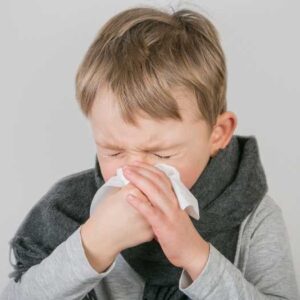 However, measles is a respiratory virus that causes a rash alongside classic upper respiratory tract symptoms like cough, runny nose, red eyes, and fever. Measles is highly contagious. Without immunity from previous infection or vaccination, 9 out of 10 people who are in contact with someone who has measles will develop an infection. Measles is spread by coughing or sneezing. People with measles are contagious from four days before through four days after a rash develops.
However, measles is a respiratory virus that causes a rash alongside classic upper respiratory tract symptoms like cough, runny nose, red eyes, and fever. Measles is highly contagious. Without immunity from previous infection or vaccination, 9 out of 10 people who are in contact with someone who has measles will develop an infection. Measles is spread by coughing or sneezing. People with measles are contagious from four days before through four days after a rash develops.
Measles Symptoms
Measles infection occurs in four distinct stages over 2-3 weeks. The first stage of measles infection is the incubation stage. It lasts approximately 10-14 days. There are no symptoms in the incubation stage.
The second phase of measles infection is called the prodrome and lasts 2-3 days. At this point, the symptoms of measles are malaise (general feeling of being unwell), mild to moderate fever (100-103.9 F or 37.7-39.9 C), dry cough, sore throat, conjunctivitis (inflamed eyes), and runny nose. This is also when Koplik’s spots appear. Koplik’s spots are small blue-white spots on the red background of the inner cheek that appear one day before the rash breaks out and last for 2-3 days. These spots confirm the diagnosis of measles, but they are only present in 60-70% of people with measles.
In the third stage of measles infection, the exanthem stage, the fever rises sharply and a distinct rash appears. This stage usually lasts about 5-7 days. The typical symptoms include high fever (104-105 F or 40-41 C), swollen lymph nodes, loss of appetite, continued cough, sore throat, red eyes, and runny nose. This is also when the full-body rash breaks out. The face breaks out in a rash first. Then the rash spreads down the arms and legs, followed by the chest and back, until it finally reaches the thighs, lower legs, and feet. The rash is clusters of small red spots that may be slightly raised, giving the skin a blotchy appearance and often a rough sandpapery feeling. On dark skin, the measles rash may look more like hyperpigmentation than redness and can easily be mistaken for something else. A measles rash is usually not itchy.
The fourth stage of measles infection is the recovery period, which takes approximately ten days. During recovery, the cough gradually resolves and the rash slowly disappears. The skin where the rash was may darken or peel during this stage.
It takes weeks or months after the rash clears for the body to rid itself of viral RNA. During this period, the immune system is weak and extra care should be taken to prevent further infections.
Measles Complications
Most people with measles fully recover; however, serious complications are more common from measles than most other childhood viral infections. According to the CDC, measles complications are more common in children under five years, adults over 20, and people with severe nutrient deficiencies. Vitamin A deficiency is associated with more severe measles infection, which is why megadoses of vitamin A are routinely prescribed at the onset of suspected measles infection.
The most current information about the rates of measles complications in our population comes from an analysis of American cases from 2002-2016. According to this data, 1/4 of people with measles are hospitalized, 1/1000 get encephalitis (swelling of the brain), and 1-2/1000 people with measles die. The last American death from measles occurred in 2015.
Neurologic Complications
Acute encephalitis is swelling of the brain, which occurs in 1/1000 measles cases and can lead to permanent brain damage. Subacute sclerosing panencephalitis (SSPE) is a rare, fatal, neurodegenerative disease that occurs 7-10 years after a measles infection.
Hearing Loss
Measles infection can lead to a severe middle ear infection (otitis media), which may lead to permanent hearing loss.
Blindness
Children with severe vitamin A deficiency who contract measles can become permanently blind. Because vitamin A deficiency is so rare in North America, this is not a concern here.
Respiratory Complications
People with measles may develop severe lung infections, like bronchopneumonia or laryngotracheobronchitis. These lung infections may be fatal in vulnerable groups like young infants and the immunocompromised.
Diarrhea
People with a measles infection may also get diarrhea, which makes staying hydrated especially important.
Measles Diagnosis
Measles can usually be diagnosed based on symptoms alone, especially if Koplik’s spots are present or if there is a known measles outbreak in the area. However, many, if not most, physicians in the United States, myself included, have never seen a measles case in person. Additionally, many viral respiratory infections may cause similar rashes. Additional testing may be required. Your doctor may take a blood sample, a urine sample, and/or a throat swab.
- Learn how to tell measles rash apart from similar rashes: Viral Exanthem Rashes In Children – Dr. Green Mom
When To See A Doctor
If you suspect your child has measles, you should immediately contact your healthcare provider. This is done to alert the healthcare system that measles in the community. Call the doctor’s office or hospital before arriving so precautions can be put into place to prevent the spread of measles.
Contact your child’s regular doctor for advice if your child develops ear pain, the fever doesn’t go down four days after the rash appears, or the coughing worsens.
Go to the emergency department or call 911 if your child is struggling to breathe or develops noisy breathing, their behavior changes or seems odd, their movement patterns change or they seem to have problems moving, they develop a severe headache, they start vomiting repeatedly, or they have a high fever (over 104-105 F or 40-41C) that doesn’t respond to fever reducing medications.
Measles Home Treatment
Measles is usually treated at home with rest and supportive care. Holistic measles treatment can include vitamin A, antiviral herbal medicine, homeopathic treatment, and various natural therapies to ease symptoms. People with measles should be considered extremely infectious for the first four days after they develop a rash and should be isolated as much as possible from the rest of the household.
Vitamin A Megadose For Measles Treatment
A vitamin A megadose for measles treatment is standard in conventional and natural medicine. The CDC recommends two megadoses on consecutive days for people diagnosed with measles. The age-based daily doses that they recommend are:
- For infants under six months, 50,000 IU x2 days
- For infants 6-12 months, 100,000 IU x2 days
- For everyone over 12 months, 200,000 IU x2 days
In my practice, I often have parents give their children vitamin A twice a year to prevent vitamin A deficiency. In those cases, vitamin A megadosing for measles treatment becomes slightly more complex.
- For more information, see Vitamin A Megadose For Viral Infections – Dr. Green Mom.
Holistic Antiviral Measles Treatment
Holistic antiviral treatment goes beyond a vitamin A megadose. Supportive lifestyle treatment is key: rest, fresh air, hydration, and a low-sugar diet are vital. Nutrient-dense foods like chicken soup, congee, and chia pudding may be helpful as well. Many integrative doctors, myself included, would also recommend a supplement protocol that includes immune enhancing nutrients and herbs.
- Learn more: Immune Support For All Ages – Dr. Green Mom
Cough Management
Measles infection produces a dry cough that is usually uncomplicated. However, I recommend staying on top of it to prevent pneumonia, which can be much more serious especially for young infants.
- For more information about how to treat coughs naturally, see Natural Treatment For Coughs – Dr. Green Mom.
Fever Management During Measles Infection
Fevers during the measles prodrome tend to be mild to moderate and are best managed with supportive herbal care. During the acute phase of measles infection, high fevers may need to be managed with fever-suppressing medication like acetaminophen or ibuprofen.
- For more information about natural fever management, see Fever Management Herbal Teas – Dr. Green Mom.
Treatment For Measles Conjunctivitis
Inflamed eyes from a measles infection can be uncomfortable. Herbal compresses with calendula, chamomile, and/or eyebright herb may help. To make an herbal compress, brew herbal tea and allow it to cool. Dip a clean washcloth in the tea, wring it out until it is damp, and place it over closed eyes.
Note: Measles is the leading cause of childhood blindness in the world. However, there is a strong link between vitamin A deficiency and measles-induced blindness. In North America, blindness as a result of measles is almost unheard of because severe vitamin A deficiency is rare.
Preventing Dehydration
Preventing and treating dehydration is always important during viral infections and measles is no different. Breast milk and formula are very hydrating, and so long as infants are feeding well, continuing with nursing or formula feeding is the best course. For older children and adults, herbal teas, popsicles, and rehydration drinks may be used to stay hydrated.
- For more information about signs of dehydration and a recipe for my homemade electrolyte drink, see this article: Signs of Dehydration In Kids And Infants & Dr. Green Mom’s Homemade Electrolyte Drink Recipe.
MMR (Measles, Mumps, Rubella) Vaccine
MMR Vaccine Efficacy – Measles
The MMR vaccine is a live-virus vaccine routinely given at 12 months and 4-6 years in the United States. The first dose is 93% effective at preventing measles; the two-dose series is 97% effective.
MMR Vaccine After Measles Exposure (Post Exposure Prophylaxis/PEP)
The MMR vaccine can be given to people without measles immunity (from previous infection or immunization) within 72 hours of measles exposure to prevent the development of serious disease. This is especially important in people at high risk of complications, as described above. Alternatively, measles immunoglobulin can be given within 6 days of measles exposure. Measles vaccine and immunoglobulin shouldn’t be given together because the immunoglobulin will prevent the body from mounting a full response to the vaccine.
MMR vaccine PEP can be given to infants over 6 months of age. Immunoglobulin can be given to infants under 6 months, if the volume of the injection isn’t too much for their body size. Pregnant women and immunocompromised people can’t receive the MMR vaccine, so immunoglobulin is usually recommended for these populations.
- To learn more about measles exposure and treatment options, see: What To Do If You’ve Been Exposed To Measles
Vaccine Derived Measles Virus Shedding
Because MMR is a live-virus vaccine, there is some concern about viral shedding. In particular, mothers wonder if they will pass virus particles to their babies through breast milk. They also worry whether unvaccinated infants in the home will be vulnerable to contracting any of the viruses in the MMR vaccine when their school-age siblings get a booster.
 As far as we know, measles weakened virus sheds for more than 14 days in healthy children and 30 days or more in immunocompromised children. There has been one unconfirmed case report of a child passing the weakened vaccine version of the measles virus to a sibling. I would consider this an unlikely occurrence in most families; however, I recommend speaking to your physician about a personalized recommendation if anyone in your family has an immunodeficiency condition.
As far as we know, measles weakened virus sheds for more than 14 days in healthy children and 30 days or more in immunocompromised children. There has been one unconfirmed case report of a child passing the weakened vaccine version of the measles virus to a sibling. I would consider this an unlikely occurrence in most families; however, I recommend speaking to your physician about a personalized recommendation if anyone in your family has an immunodeficiency condition.
Measles, mumps, and rubella attenuated viruses may pass through breast milk. There are no recorded cases I can find of infants contracting measles or mumps through the breast milk of recently vaccinated mothers; however, there are some case reports of infants contracting rubella. In the cases where infants contract rubella, they recover quickly and easily, likely because the virus is weakened and they benefit from the antibodies their mothers produce in response to the vaccine. The MMR vaccine is generally considered safe while breastfeeding; however, I urge caution in some cases, especially if any immune deficiency conditions are present.
Who Shouldn’t Get The MMR Vaccine?
The MMR vaccine has a long list of precautions and contraindications on the CDC pinkbook site. In short, contraindications to MMR include moderate to severe illness of any kind; immune-deficient states including HIV, chemotherapy, and high dose corticosteroid treatment; and allergy to any vaccine components.
According to the CDC, women should avoid getting pregnant for four weeks after getting the MMR vaccine and pregnant women shouldn’t get the vaccine.
Side Effects, Vaccine Ingredients, And Controversy Surrounding The MMR Vaccine
For information about side effects and ingredients of the MMR vaccines, see the package inserts: M-M-R-II, ProQuad (Fridge), ProQuad (Frozen). I discuss the MMR vaccine, ingredients, side effects, and controversy in more detail in this post: Measles, Mumps, Rubella (MMR) – Dr. Green Mom. The CDC pink book entry on measles is also a good source of information about measles and the measles vaccine.
Summary
Measles is a viral respiratory infection characterized by cough, runny nose, inflamed eyes, high fever, and full body rash. It is uncommon in the United States due to high rates of vaccination. The vaccine is up to 97% effective at preventing measles if given twice. According to the most recent data, a quarter of people with measles need hospitalization. It is important to know the warning signs regarding when to seek medical care. Home measles treatment involves the same measures as any other viral infection with an important reminder that measles is extremely contagious. Care must be taken to avoid spreading the infection.
References:
For Healthcare Professionals – Diagnosing and Treating Measles | CDC
van der Maas, N. A., Woudenberg, T., Hahné, S. J., & de Melker, H. E. (2016). Tolerability of Early Measles-Mumps-Rubella Vaccination in Infants Aged 6-14 Months During a Measles Outbreak in The Netherlands in 2013-2014. The Journal of infectious diseases, 213(9), 1466–1471. https://doi.org/10.1093/infdis/jiv756
Kontio, M., Palmu, A. A., Syrjänen, R. K., Lahdenkari, M., Ruokokoski, E., Davidkin, I., Vaarala, O., & Melin, M. (2016). Similar Antibody Levels in 3-Year-Old Children Vaccinated Against Measles, Mumps, and Rubella at the Age of 12 Months or 18 Months. The Journal of infectious diseases, 213(12), 2005–2013. https://doi.org/10.1093/infdis/jiw058
Kuter, B. J., Marshall, G. S., Fergie, J., Schmidt, E., & Pawaskar, M. (2021). Prevention of measles, mumps and rubella: 40 years of global experience with M-M-RII. Human vaccines & immunotherapeutics, 17(12), 5372–5383. https://doi.org/10.1080/21645515.2021.2007710
Di Pietrantonj, C., Rivetti, A., Marchione, P., Debalini, M. G., & Demicheli, V. (2021). Vaccines for measles, mumps, rubella, and varicella in children. The Cochrane database of systematic reviews, 11(11), CD004407. https://doi.org/10.1002/14651858.CD004407.pub5
Semba, R. D., & Bloem, M. W. (2004). Measles blindness. Survey of ophthalmology, 49(2), 243–255. https://doi.org/10.1016/j.survophthal.2003.12.005
Drugs and Lactation Database (LactMed) [Internet]. Bethesda (MD): National Library of Medicine (US); 2006-. Measles-Mumps-Rubella Vaccine. [Updated 2021 Apr 19]. Available from: https://www.ncbi.nlm.nih.gov/books/NBK501034/
Jain P, Rathee M. Koplik Spots. [Updated 2022 May 8]. In: StatPearls [Internet]. Treasure Island (FL): StatPearls Publishing; 2022 Jan-. Available from: https://www.ncbi.nlm.nih.gov/books/NBK549793/
Moss W. J. (2017). Measles. Lancet (London, England), 390(10111), 2490–2502. https://doi.org/10.1016/S0140-6736(17)31463-0
Gastañaduy, P. A., Goodson, J. L., Panagiotakopoulos, L., Rota, P. A., Orenstein, W. A., & Patel, M. (2021). Measles in the 21st Century: Progress Toward Achieving and Sustaining Elimination. The Journal of infectious diseases, 224(12 Suppl 2), S420–S428. https://doi.org/10.1093/infdis/jiaa793
Imdad, A., Mayo-Wilson, E., Herzer, K., & Bhutta, Z. A. (2017). Vitamin A supplementation for preventing morbidity and mortality in children from six months to five years of age. The Cochrane database of systematic reviews, 3(3), CD008524. https://doi.org/10.1002/14651858.CD008524.pub3
Lo Vecchio, A., Cambriglia, M. D., Bruzzese, D., & Guarino, A. (2021). Vitamin A in Children Hospitalized for Measles in a High-income Country. The Pediatric infectious disease journal, 40(8), 723–729. https://doi.org/10.1097/INF.0000000000003156
Hester, G. Z., Nickel, A. J., Stinchfield, P. A., & Spaulding, A. B. (2020). Low Use of Vitamin A in Children Hospitalized for Measles in the United States. The Pediatric infectious disease journal, 39(4), e45–e46. https://doi.org/10.1097/INF.0000000000002574
Griffin D. E. (2016). The Immune Response in Measles: Virus Control, Clearance and Protective Immunity. Viruses, 8(10), 282. https://doi.org/10.3390/v8100282
Bühl, D., Staudacher, O., Santibanez, S., Rossi, R., Girschick, H., Stephan, V., Schmidt, B., Hundsdoerfer, P., von Moers, A., Lange, M., Barker, M., Mall, M. A., Heininger, U., Matysiak-Klose, D., Mankertz, A., & von Bernuth, H. (2022). Specifically Increased Rate of Infections in Children Post Measles in a High Resource Setting. Frontiers in pediatrics, 10, 896086. https://doi.org/10.3389/fped.2022.896086
Nestibo L, Lee BE, Fonseca K, Beirnes J, Johnson MM, Sikora CA. Differentiating the wild from the attenuated during a measles outbreak. Paediatr Child Health. 2012 Apr;17(4):e32-3. doi: 10.1093/pch/17.4.e32. PMID: 23543773; PMCID: PMC3381670.
Di Pietrantonj, C., Rivetti, A., Marchione, P., Debalini, M. G., & Demicheli, V. (2021). Vaccines for measles, mumps, rubella, and varicella in children. The Cochrane database of systematic reviews, 11(11), CD004407. https://doi.org/10.1002/14651858.CD004407.pub5
Khampanisong, P., Pauly, M., Nouanthong, P., Vickers, M. A., Virachith, S., Xaydalasouk, K., Black, A. P., Muller, C. P., & Hübschen, J. M. (2021). Waning of Maternal Antibodies against Measles Suggests a Large Window of Susceptibility in Infants in Lao People’s Democratic Republic. Pathogens (Basel, Switzerland), 10(10), 1316. https://doi.org/10.3390/pathogens10101316
Brinkman, I. D., Butler, A. L., de Wit, J., van Binnendijk, R. S., Alter, G., & van Baarle, D. (2022). Measles Vaccination Elicits a Polyfunctional Antibody Response, Which Decays More Rapidly in Early Vaccinated Children. The Journal of infectious diseases, 225(10), 1755–1764. https://doi.org/10.1093/infdis/jiab318
Haratian K, Mohseni Meybodi A. Evaluation of Inhibitory Effects of Berberine on Apoptosis Due to Measles Virus Strain AIK-HDC . aumj 2012; 1 (2) :77-84
Chovatiya R, Silverberg JI. Inpatient morbidity and mortality of measles in the United States. PLoS One. 2020 Apr 28;15(4):e0231329. doi: 10.1371/journal.pone.0231329. PMID: 32343688; PMCID: PMC7188204
Cohen BE, Durstenfeld A, Roehm PC. Viral causes of hearing loss: a review for hearing health professionals. Trends Hear. 2014 Jul 29;18:2331216514541361. doi: 10.1177/2331216514541361. PMID: 25080364; PMCID: PMC4222184.
